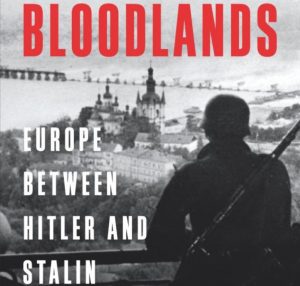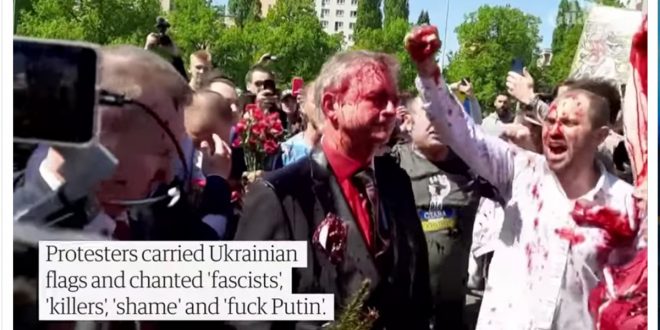Sandy Baksys.
Sometimes the buried war crimes of the past and the brazen crimes of the present vibrate at the same emotional frequency.
This was clearly the case at a recent World War II “Victory Day” incident in a Soviet military cemetery in Warsaw. Online videos showed the Russian ambassador to Poland being spattered with red paint by demonstrators holding Ukrainian flags, as they taunted him with shouts of “fascist murderer.”

Watching from a distance of some 8,000 miles and 80 years, I felt a brief but savage thrill of payback – and it wasn’t only for Russia’s present crimes in Ukraine.
What I felt was also for my father’s family, forever scattered and broken by the Soviet invasion of Lithuania in 1944. For my crippled Lithuanian aunt who was gang-raped by Soviet soldiers when she couldn’t flee. For my Lithuanian grandmother, who died in exile without ever seeing half of her children again.
Throughout the 1930s and ‘40s, in a mixture of ethnic and ideological “cleansing,” Soviet dictator Josef Stalin starved, tortured, murdered, or deported millions.
One death is a tragedy; a million deaths are a statistic,” Stalin has been quoted as saying, probably because it is so easy to imagine him saying it.
But the reverse is also true. And that’s how the symbolic “bloodying” of one Russian official in May 2022 could evoke even a fleeting moment of accountability, of vindication, for countless Soviet victims.
Who’s the Fascist?
“Many hesitate to see today’s Russia as fascist because Stalin’s Soviet Union defined itself as antifascist,” Yale historian Dr. Timothy Snyder wrote May 19 in the New York Times under the headline: “We Should Say it. Russia is Fascist.”
Snyder asserts that fascist dictators and their irrational ideologies of hate can only be defeated on the battlefield. Ergo, debunking Putin’s myth that Ukraine must be destroyed in order to “de-Nazify” it requires Russia definitively to lose this war.
But I believe we must also leverage world opinion against the myth of then-Soviet, now-Russian, antifascism upon which Putin’s threat to all Eastern Europe – not just Ukraine – historically pivots.
On the one hand, Snyder demonstrates how Putin’s attack on Ukraine is fascist. On the other, he details the many ways in which the Soviet Union, despite being Hitler’s enemy (after being his ally), was only expediently, never ideologically, antifascist.
The obvious question is, could antifascism have been any more of a justification for violently suppressing Baltic nationhood during and after WWII than it is for Putin’s war against today’s Ukraine?
Two Birds with One Stone
And that’s precisely the question we want the world to be asking: whether, in fact, “glorious” Soviet-Russian antifascism has ever been either glorious or non-fascist. If it’s ever been anything other than a tool for brutal territorial conquest and occupation.
The most defamatory “Nazi” elements of Putin’s anti-nationalist hate speech clearly emanate from Soviet Stalinist anti-nationalist hate speech. And this creates a unique opportunity for undermining both by undermining either.
Stalinist “antifascist” crimes become clear in analogy to Putin’s “antifascist” criminal war. (It’s hard to speak merely of “war crimes” when Putin’s entire war against Ukraine is a crime.)
Vice-versa, Putin’s mythology, the one that allows him to prosecute a brutal, fascist assault while defaming his victims as “Nazis,” finds its perfect analogy in the same propaganda against the U.S.S.R’s Baltic and Ukrainian nationalist victims.
Cue the Tribunal
The very fact that Putin’s new war deploys a false WWII-era justification proves it is never too late, even for a 75-year overdue reckoning.

Indeed, as Russia pounds Ukraine into rubble so it can re-hoist the Soviet flag – and the rest of once-Soviet Europe quakes at the spectacle – an international tribunal on Soviet-era crimes seems not only imperative but also doable.
For decades, Russia has deployed Stalin’s defeat of Hitler to stand itself in heroic moral contrast to Nazi Germany. Allies Britain, France, and the U.S. aided in the immediate post-war coverup by failing to prosecute a single Soviet mass-murderer while condemning the entire Nazi leadership.
Likewise, every court dispensing WWII-era justice since that time has concerned itself with lesser Nazis, but still, only Nazis.
Yet, as Snyder’s breakthrough 2012 book, “Bloodlands: Europe Between Hitler and Stalin,” proved, Stalin’s record of mass murder does not, in fact, pale to invisibility next to Hitler’s. And with historians like Snyder leading the charge, the totalitarian nightmare of Soviet communism can still be belatedly and globally rebuked without diminishing any of the particular evils of Nazism if that is a concern.
Our Third Chance for Historical Reckoning
At the very least, the Soviet Union must be stripped of its “myth of victory,” in which Russia still claims the monopoly on Nazi victimhood and victory.
At the end of the Cold War, the West missed its first follow-up chance to shine a light on Soviet Russian crimes against humanity. Perhaps in that moment of apparent Soviet collapse, it seemed like overkill.
But it turns out that the wounded beast only staggered into hiding and has since returned with a vengeance. And if we don’t seize this third chance to put a stake in the monster’s heart, we will continue to face a Russia that – unlike Nazi Germany – still never admits fault, never renounces conquest, and never provides an iota of reparative justice while traumatizing millions of new victims.
The article was published in “Draugas NEWS”, May 2022 edition.
 DRAUGAS NEWS Lithuanian World Wide News in English
DRAUGAS NEWS Lithuanian World Wide News in English
